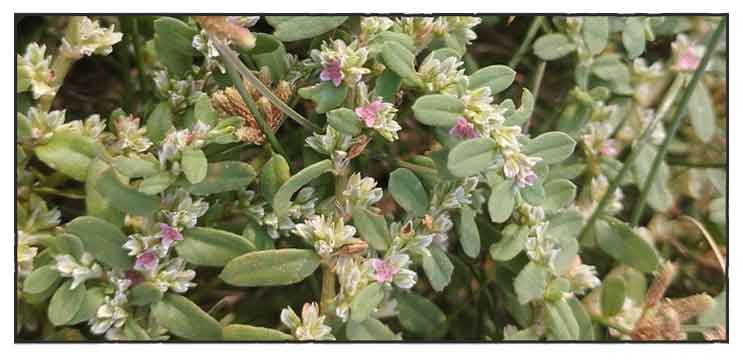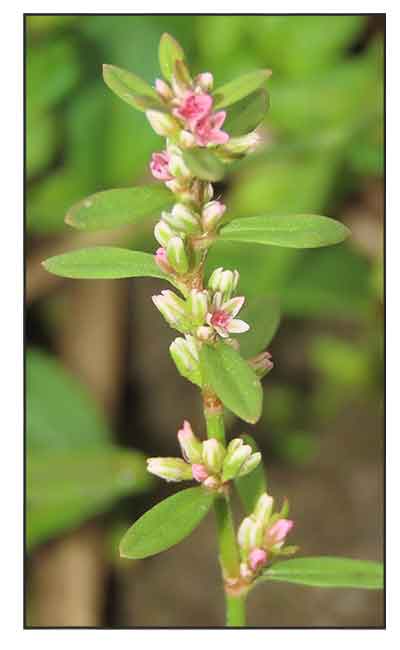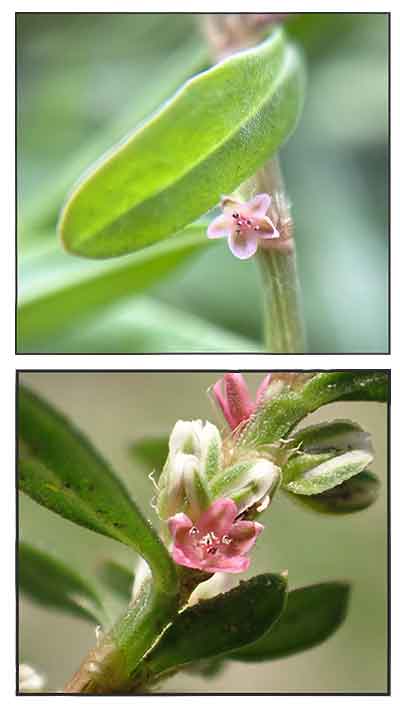 Gen info Gen info
- Polygonum is a genus of about 130 species of flowering plants in the buckwheat and knotweed family Polygonaceae. Common names included knotweed and knotgrass. The genus was first described by Carl Linnaeus in 1754. (3)
- Former genera such as Polygonella have been subsumed into Polygonum; other genera have been split off. (3)
- Etymology: The genus name is derive from Greek poly (many) and gonu (knee or joint), referring to the swollen jointed stem. Alternatively, Matthias Martinius (Scribonius Largus) offers etymology as derived from gonos (seed), the meaning being the Latin fecundus (with many offspring). Flora of North America says the derivation meaning 'many seeds' is the "grammatically correct interpretation". (3)
- The species Polygonum plebeium was first described by Robert Brown in 1810.
 Botany Botany
• Herbs annual. Stems prostrate, 10-40 cm tall, much branched from base, usually internodes shorter than leaves. Petiole very short or nearly absent; leaf blade narrowly elliptic or oblanceolate, 5-15 × 2-4 mm, both surfaces with conspicuous midvein and inconspicuous lateral veins, base narrowly cuneate, margin entire, apex obtuse or acute; ocrea white, 2.5-3 mm, membranous, apex lacerate. Flowers 3-6, in axillary fascicles; bracts membranous. Pedicels shorter than bracts, articulate at middle. Perianth green, margin white or pinkish, 5-parted; tepals narrowly elliptic, 1-1.5 mm, abaxially with prominent veins. Stamens 5; filaments included, slightly dilated at base. Styles 3, rarely 2, very short; stigmas capitate. Achenes included in persistent perianth, black-brown, shiny, broadly ovoid, trigonous or biconvex, 1.5-2 mm, smooth. (Flora of China)
• Plants bluish green, homo-phyllous. Stems prostrate, much-branched from base, not wiry, 10-40 cm, papillose-scabridulous. Leaves: ocrea 1-veined, 2.5-3 mm, proximal part cylindric, distal part laciniate; petiole 0-1 mm; blade bluish green, narrowly elliptic or oblanceolate, 5-16 × 1-4 mm, margins flat, apex obtuse or acute, papillose-scabridulous; stem leaves 1-1.5(-2) times longer than adjacent branch leaves, distal leaves overtopping flowers. Inflorescences axillary; cymes uniformly distributed, 3-6-flowered. Pedicels exserted from ocreae, 3-5 mm. Flowers closed; perianth 1-1.5 mm; tube 12-27% of perianth length; tepals overlapping, green with white or pink margins, petaloid, not keeled, elliptic, cucullate; midveins unbranched, thickened; stamens 5. Achenes enclosed in perianth, black-brown, broadly ovate, 2-3-gonous, 1.5-2 mm, faces subequal, apex not beaked, edges concave, shiny, smooth; late-season achenes common, 2-4 mm. (Flora of North America)
Distribution
- Native to the
Philippines. (2)
- In Luzon: Benguet, Cagayan, Isabela.
- In open sites along streams at low elevation , ascending to 1400 m in Benguet. (1) (2)
- Also native to
Andaman Is., Angola, Assam, Bangladesh, Benin, Botswana, Burkina, Cambodia, Cape Provinces, Chad, China North-Central, China South-Central, China Southeast, DR Congo, East and West Himalaya, Egypt, Eritrea, Eswatini, Ethiopia, Free State, India, Inner Mongolia, Jawa, Kazakhstan, Korea, KwaZulu-Natal, Laos, Madagascar, Malawi, Mali, Manchuria, Mauritania, Mozambique, Myanmar, Namibia, Nepal, New South Wales, Niger, Nigeria, Northern Provinces, Northern Territory, Pakistan, Qinghai, Queensland, Senegal, South Australia, Sri Lanka, Sudan-South Sudan, Taiwan, Tanzania, Thailand, Tibet, Victoria, Vietnam, Western Australia, Zambia, Zimbabwe. (1)
Constituents
- Study of crude methanolic fraction yielded secondary metabolites: saponins, tannins, phenol, flavonoids, carbohydrates, protein, alkaloids, oils and fats. Study for TPC and TFC yielded total phenolics of 64.62 mg/GAE/g and total flavonoids of 70.47 mg RTE/g. (7)
- Scanning electron microscope (SEM) analysis detected xylem parenchyma, phloem parenchyma, and calcium oxalate crystals. Preliminary phytochemical study identified secondary phytoconstituents such as alkaloids, carbohydrates, flavonoids, proteins, and amino acids. Powdered medications EDX examination showed presence of nitrogen, aluminum, silicon, chlorine, potassium, zinc, zirconium and thallium. FT-IR revealed several function groups, including alcohols, amines, carboxylic acids, phenols,, alkanes, and ketones. (9)
- Nutraceutical study of aerial parts revealed essential nutrients: carbohydrate (69.63% w/w), protein (1.30% w/w), total ash (11.68% w/w), moisture (13.10% w/w) and energy (140.26 Kcal/100g). HPLC confirmed the presence of gallic acid (0.049 µg/mg) and piperine (0.234 µg/mg) in the aerial parts. (11)
- UHPLC/MS of methanol extract
identified more than 50 compounds. Flavonoids were the main components derived from isovitexin, kaempferol, and luteolin; while gallic acid, protocatechuic acid, gingerols, and lyoniresinol 9'-sulfate were among important bioactive phenols. (see study below) (14)
Properties
- Studies have suggested anti-inflammatory, antioxidant, cardioprotective, hypolipidemic, membrane stabilizing, thrombolytic, antifibrotic, antibacterial, antidiarrheal, analgesic, enzyme inhibitory properties.
Parts used
Leaves, whole plant.
 Uses Uses
Edibility
- Reportedly used as famine food in tribal communities of Bihar, Jharkhand, Uttar Pradesh, and Orissa. (6)
Folkloric
- No reported folkloric medicinal use in the Philippines.
- In rural communities of Shahjahanpur, Uttar Pradesh, India, long used for treatment of intestinal symptoms and pneumonia. Leaf powder combined with mishri for treatment of menstruation problems. Used for treatment of diarrhea, eczema, inflammation, liver illness, and ringworm. (6) In Rajasthan, decoction from plant parts used for alleviating colic inflammation. Mixture of plant ash and oil used topically for treatment of eczema. (7) Crushed leaves used for treatment of dandruff. (8) In Assam, powdered plant taken for pneumonia and bowel complaints. (•) In Tamil Nadu, leaf paste used for treatment of bone, kidney, and liver disorders.
- In Pakistan, decoction of root and shoot used as galactagogue and liver tonic, for treatment of pneumonia, and heartburn and promotion of regular bowel movements. (7) Used for treatment of jaundice and hepatitis. (13)
- In African traditional medicine, powdered seeds and roots taken orally to relive digestive disorders. In the Shekhawati region of Rajasthan, India, plant decoction used for colic inflammation. Topical of plant ash mixed with oil used for eczema. (8)
- In the Himalayan region of Bhutan, whole plant used for treatment of eczema, leg and finger infections, swelling and wounds. (15)
- In Nepal, plant decoction drunk for bloody diarrhea. (17)
Others
- Cosmetics / Scent: In India, crushed leaves are included in local perfume preparations. (8)
Studies
• Anti-Inflammatory: Study of evaluated the anti-inflammatory effect of aqueous methanolic extract of P. plebeium (AMEPP). The AMEPP dose dependently inhibited egg albumin and bovine serum albumin denaturation 72.99% and 67.51% respectively. The extract significantly reduced inflammation (48.7% and 40.63%, respectively) against carrageenan and egg albumin-induced paw edema models. The anti-inflammatory effects was attributed to presence of secondary metabolites. Results confirm its traditional use for inflammatory conditions. (5)
• Cardioprotective / Hypolipidemic / Antioxidant / Thrombolytic: Study evaluated the cardio-protective and antioxidant effects of crude methanolic extract and fractions of Polygonum plebeium. Rats were pretreated with extract and fractions followed by administration of isoproterenol Hcl (ISO) after 24 h for 2 days. The chloroform fraction exhibited significant decreased levels of ALT, AST, CPK, and LDL in the serum. At 250 mg/kg the extract exhibited significant effects and reduced levels of biomarkers associated with MI. Acute toxicity study showed safety up to a dose of 3 g/kbw, with no systemic toxic effects. The PpCF demonstrated considerable reduction in TC, TG, and LDL levels, comparable to standard Simvastatin. Compared to ISO-treated group, prophylactic treatment with PpCF significantly increased CAT and SOD activities. For thrombolytic activity, PpCF showed moderate lysis of 45.49% and 35.48% with doses of 400 and 200 µL respectively. Results confirmed the chloroform fraction possesses antihyperlipidemic, membrane stabilizing, and thrombolytic potentials suggesting potential for isolation of a natural product from P. plebeium for management of cardiovascular problems. (7)
• Antibacterial Against Staphylococcus aureus: Study evaluated Polygonuum plebeium (PP) and Euphorbia hirta for antibacterial activity against S. aureus, B39 using agar diffusion method. Ethyl acetate extracts showed to be the most effective solvent. MIC was 25 mg/ml. Antimicrobial activity was more effective when incubated at 25°C for 10 mins with MRSA, B39. (10)
• Antibacterial Against Staphylococcus aureus/ Antioxidant / Antidiarrheal / Analgesic: Study evaluated a methanolic extract of P. plebeium (MEPP) and its Kupchan fractions for invitro antioxidant, antibacterial, and in vivo antidiarrheal and analgesic activities in mice model. The n-hexane fraction showed DPPH scavenging activity with IC50 of 24.2 µg/ml. Both n-hexane and EA fractions exhibited activity against Pseudomonas aeruginosa with ZOI of 20.0 and 14.0 mm, respectively. Oral MEPP at 200 mg/kbw effectively (p<0.01) reduced castor oil-induced diarrhea by 58.70%. In acetic acid-induced writhing, MEPP at 400 mg/kbw showed significant (p<0.001) inhibition of writhing responses by 50.0%, compared to standard diclofenac 10 mg/kg with 77.91% inhibition in mice. In tail-immersion method, the MEPP showed substantial (p<0.001) reduction in pain sensation in mice. (12)
• Anti-Fibrotic in CCl4-Induced Hepatic Damage and Fibrosis / Whole Plant: Study evaluated the anti-fibrotic effects of P. plebeium in carbon tetrachloride (CCl4)-induced hepatitic toxicity and fibrosis in rats. Whole plant extracts were administered by oral gavage. Treated groups showed ablation in liver damage, along with decrease in elevated levels of AST, ALT, and γGT. Restoration of CCl4-induced fibrosis was evidenced by significant suppression of alpha-smooth muscle actin (α-SMA), tumor growth factor beta (TGF-ß) and collagen mRNA expression levels. Histological study of liver sections showed improvement in CCl4-induced fibrosis. (13)
• Antioxidant and Enzyme Inhibition Potential / Functional Food Ingredients: Study evaluated the medicinal potential and secondary metabolic picture of methanol extract (PP-M) of Polygonum plebeium and fractions. The ethyl acetate fraction (PP-E) showed highest contents of phenolic (89.38 mgGAE/g) and flavonoids (51,21 mgQE/g), and highest antioxidant potential in DPPH, ABTS, CUPRAC, and FRAC assays. PP-W showed strong inhibition of enzyme AChE (4.03 mgGALAE/g), while PP-H showed potent inhibition of BChE (5.62 GALAE/g extract). Against tyrosinase activity, PP-E was the most active fraction with inhibitory value of 71.89 mg KAE/g extract. Antidiabetic potential was equally distributed among PP-M, PP-H, and PP-E. (14)
Availability
- Wild-crafted.
|

![]()




 Botany
Botany Uses
Uses